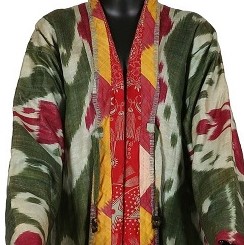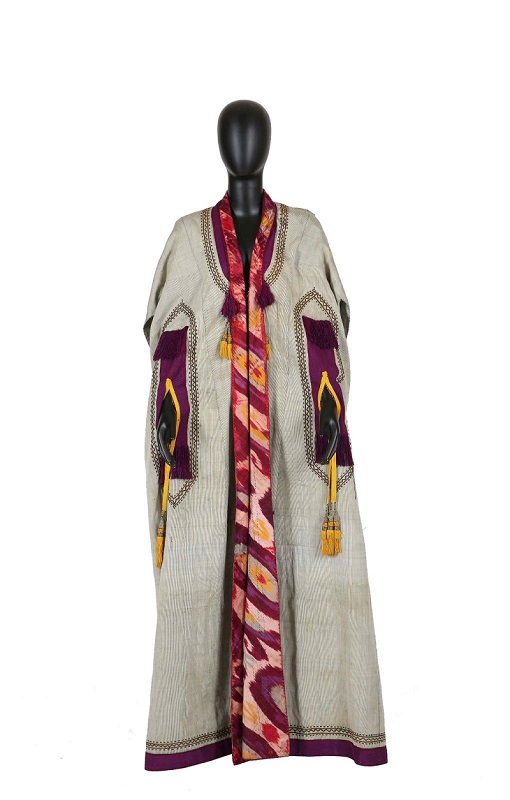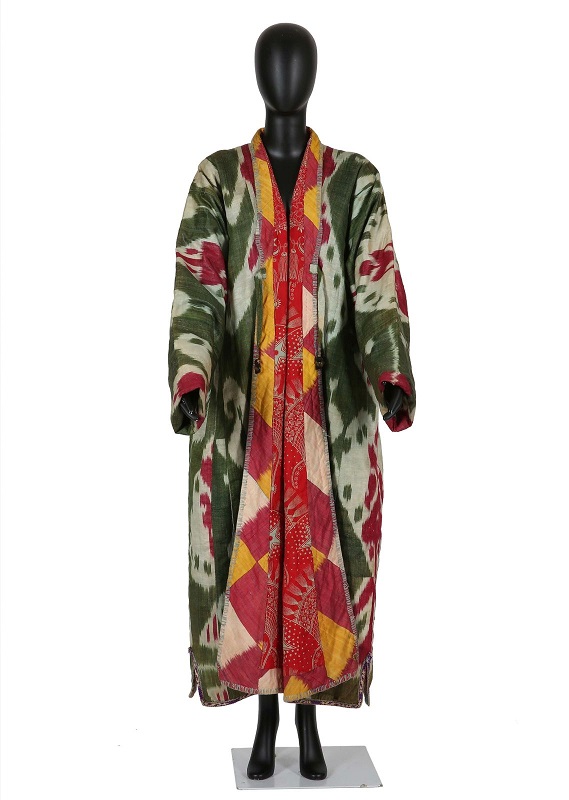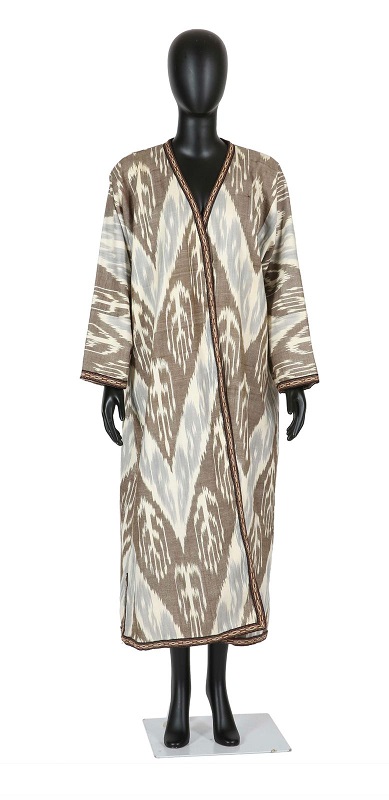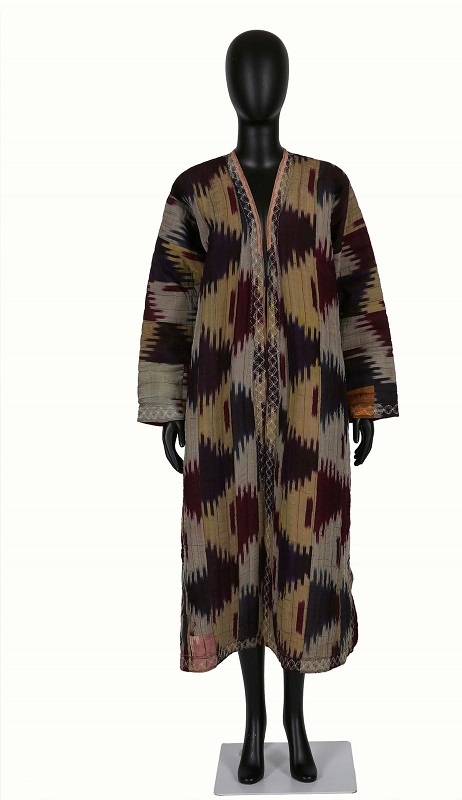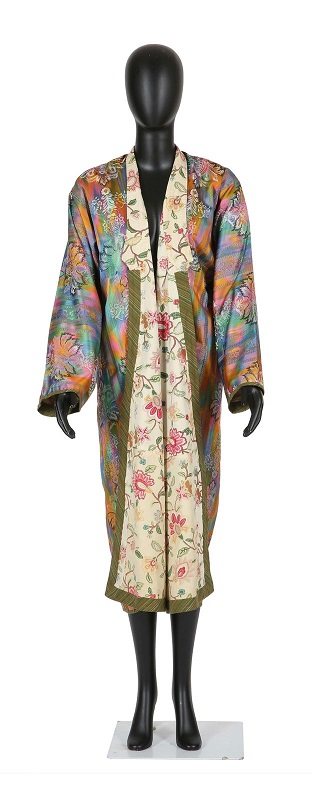This is an edited extract from Textiles and Clothing along the Silk Roads edited by Feng Zao and Marie Louise Nosch, produced and published by UNESCO. ISBN: 978-92-3-100539-8. The article is illustrated using items from The Zay Collection. This is a shortened version of Chapter 16 – Ikat of Central and West Asia, written by Professor Elmira Gyul, Doctor of Art Criticism and Chief Researcher at the Institute of Art Studies of the Academy of Sciences of the Republic of Uzbekistan.
What is Ikat?
Ikat – resist dye fabrics – are known in Central and Southeast Asia, China, India, Japan, the Middle East, West Africa, and Latin America. However, the time and place of the origin of this specific dyeing technique, giving its characteristic vibrating decor, remains a mystery. One expressed view is that it had one point of origin, however, it is equally likely that it appeared in different regions and countries independently. In any case, the early samples of ikats found in different parts of the world enable us to speculate on the contacts made between human groups, the migration of ideas and technologies, and the cultural exchanges that occurred between different countries and regions in the distant past.
There is also an opinion that resist dyeing is one of the oldest methods of fabric colouring. It was originally used for fabrics or garment pieces that were already woven. According to this method, some parts of the fabric were tied into a knot, stitched or compressed to make them less accessible to a dye solution of a certain colour (tie-dyeing). This method has been known since antiquity in Egypt and China, India, Indonesia, Mexico, Peru and Japan. The most famous products made with this technique are Bukhara and Margilan silk shawls known as kaigaly (kalgai, kelagai).
Silk, cotton, wool, linen, and other fibres were used to produce ikat fabrics. The technology comprised warp-only dyeing (warp-ikat), weft-only dyeing (weft-ikat), or both warp and weft dyeing (double-ikat). The ornamentation could be either abstract or figurative. All these factors are important when trying to identify possible migration pathways of the resist-dyeing technology.
The origin of Ikat
The term ‘ikat’, used in scientific and popular literature to indicate the entire body of resist-dyed cotton and silk fabrics, is rather recent and does not reflect its name. It originates from the Malay-Indonesian word mengikat, meaning ‘to weave, knot, put together, wrap, twine everything around’. The process includes step-by-step reservation of warp or weft threads before their subsequent dyeing, even before the threads are placed onto the loom. This term was proposed by the Dutch researcher, Gerret Pieter Rouffaer, who studied Indonesian resist-dyed textiles at the beginning of the twentieth century. The word Ikat is now used for ready-made, decorative, resist-dyed textiles, regardless of their place of manufacture.
The earliest samples of ikats known today are geographically related to China. These fragments were found at the Horyuji Buddhist Temple in Nara, Japan, and date back to 552–644. They are now housed at the Tokyo National Museum.
The eight earliest documented fragments of cotton warp-ikats were excavated among 251 textile fragments in Nahal ‘Omer located in ‘Arava Valley (Israel) and date from 650–810 CE. Orit Shamir and Alisa Baginski, who published the results of the study of those fragments, believe that they could have been brought from Yemen or India. As evidence, the authors refer to the famous wall paintings in the Ajanta caves and silk artefacts found in Central Asia.
Ikat in the Arab world
Cotton ikats from Yemen, dating back to the ninth and early tenth centuries, belong to another group, and a well-known collection of these fabrics is stored in The Metropolitan Museum of Art, New York. These textiles belong to the same cultural circle as the earlier fragments from Israel (650–810 CE). In the Arab world, ikats were known as asb from Arabic asaba, meaning ‘to bind’.
Their local production apparently began in the ninth century when cotton was cultivated on the arid Arabian Peninsula. Textile experts do not exclude interconnections between the two weaving traditions of Southeast Asia and the Middle East.
Potential influences are also indicated by the design of the survived fabrics, exclusively abstract and consisting of vibrating stripes, ‘feathers’ and rhombuses. It can be surmised that the choice in favour of abstractions found in both the early Indian ikats (known from the paintings of Ajanta) and Chinese ikats was associated with the technology of resist-dyeing, which is not particularly suitable for creating figurative images (mythological plots are found mainly on ikats from Indonesia).
Ikat influenced by Islam
However, for the Muslim world, abstract design was a deliberate choice, a reflection of the aesthetic priorities of Islam, inspired by an inconceivable God. The fact that the abstract style of Arab ikats could not only have decorative but also symbolic meaning is evidenced by the Arabs’ attitude towards textiles as carriers of information. It was the Arabs who were the first to produce tirazes – ikats with inscriptions on them.
Calligraphic lines in Arabic were either embroidered or inked onto the fabric. Calligraphy had a sacred meaning in the culture of Islam. As a result, the epigraphic inclusion emphasised the highest status of this type of fabric. It is no coincidence that they were made in specialised workshops under royal supervision.
Arabic epigraphy on textiles, carpets, crockery, and the walls of buildings defined the period when Islam conquered new territories, presenting the Quranic tenets to indigenous peoples and attracting them with wise moral admonitions and benevolent statements. Even if the inscription could not be read, it was perceived as a sign of the Quran, the most sacred object for Muslims. In general, the inscriptions, as a formidable scholar of Islamic art and architecture, Lisa Golombek, put it, played the same role as figures in paganism and Christianity.
Thanks to the inscriptions, we can consider the Arab asb fabrics as important religious symbols, conveying new religious rules and norms. In the first centuries of Islam, when the new religion sought to win the hearts and minds of people, textiles acquired a social function and became one of the tools for introducing a new faith.
In the collection of The Metropolitan Museum of Art, there is a fragment of an ikat (Acc. No. 29.179.17) with the inscription al-mulklillah meaning ‘Dominion belongs to God’ embroidered in Kufic script. Such inscriptions once again emphasise the role of textiles in expressing and spreading new religious ideals. Asb cotton fabrics, which sidelined the famous silk samites, were an expression of religious piety.
Uzbek ikat
Later ikats in the Central and West Asia region have not survived. In the nineteenth to the early twentieth century, a new bright star in the history of ikat weaving in Central Asia was ignited. The territory of this region was then divided into three Uzbek states (the Khanates of Khiva and Kokand, and the Bukhara Emirate). This period provides us with numerous surviving samples of whole silk and semi-silk resist-dyed fabrics, unique in their artistic qualities.
It should be noted that the Central Asia region has a truly unique landscape favourable to the development of various types of textile production. The oases were a hub for sedentary agricultural populations cultivating kenaf (Hibiskus cannabinus), cotton and silk, whereas the steppes and foothills were suitable habitats for sheep and goat herders who supplied plenty of sheep wool (fleece) and wool products to local markets. A large variety of fibre materials led to the emergence of multiple types of textile arts and crafts, such as embroidery, gold embroidery, printed cloth, carpet weaving, felting, and cotton and silk weaving. Each of these crafts is unique. But is there any better-known local symbol than ikat fabrics?
Arab influence on Uzbek Ikat
The resist dyeing technology and the tradition of ikat fabrics could have penetrated Central Asia both from the East (China) and from the West (Yemen, during the period of Arab conquests and the spread of Islam). Considering that ikats produced in Central Asian Uzbek khanates include half-silk and whole silk fabrics, it can be concluded that half-silk weaving (fabrics with a silk warp and a cotton weft) was a compromise that allowed Arab cotton fabrics of the asb variety to adapt to the needs and desires of the Central Asian Muslim population, whereas whole silk was under the influence of the silk atlas weavings of China.
In China and west Turkestan, as well as in the Middle East (Yemen), only the warp threads were ornamented and dyed, which a priori allows us to consider all three regions within the framework of one silk weaving tradition. Ikats of Central Asia were therefore formed under various influences and were transformed depending on local tastes.
The spread of resist-dyeing technology in Asia was associated with the Silk Roads – the famous trade routes along which not only goods but also ideas moved. Trade with China, the military expansion of the Arabs, and the new aesthetic ideals introduced with the new religion of Islam contributed to the rooting of ikat fabrics in Mawarannahr.
Continue the fascinating story of Ikat here.
Research Opportunity
To help us to complete the ambitious task of researching our growing collection, we are calling out for researchers and people with knowledge, interest, time, money, or other resources to help us fulfil our mission ‘of advancing the preservation of cultural heritage through the collection, documentation and digital archiving of Arab historical attire and their stories.If this is you, or you know of someone who might be of assistance, please contact us at info@thezay.org
